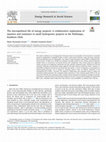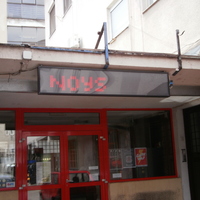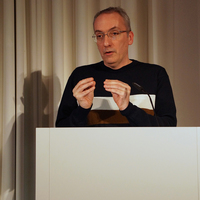Conference Presentations by Maite Hernando-Arrese
I Armed Myself: Seeds and Women Companionship in Southern Chile
This is a little story of my encounter with some seed keepers women of Curarrehue, who are part o... more This is a little story of my encounter with some seed keepers women of Curarrehue, who are part of "Las Guardianas del Territorio" an organization created in 2015 to preserve and protect ancestral knowledge, as well as native seeds, food sovereignty and more broadly the defense of life. The story that I will tell you is about seeds with a history, which are to some extent under threat by the increase of agricultural monocultures, and the biopiracy arrival in Chile.
Esta presentación es parte de una investigación en curso orientada a estudiar de qué modo el desa... more Esta presentación es parte de una investigación en curso orientada a estudiar de qué modo el desarrollo de proyectos de energías renovables en el sur de Chile, está cambiando el entorno y la cotidianeidad de las/os habitantes rurales y Mapuche de la comuna de Panguipulli, Región de los Ríos.
Papers by Maite Hernando-Arrese

Chungara, 2023
En este artículo se analiza el rol político de la esperanza en la resistencia contra proyectos hi... more En este artículo se analiza el rol político de la esperanza en la resistencia contra proyectos hidroeléctricos en territorio mapuche de las comunas de Curarrehue y Panguipulli, Chile. Siguiendo un enfoque micropolítico, nuestro objetivo es comprender, por una parte, las tensiones y conflictos que esta resistencia produce al interior de las comunidades locales y, por otra parte, el rol político de la esperanza en la lucha por la defensa de la vida que levantan movimientos indígenas y ambientales. A partir de lo anterior, buscamos contribuir a la literatura sobre movimientos de esperanza desde la perspectiva de la ecología micropolítica, así como al debate sobre el rol que tienen las emociones y los afectos en la movilización social. A través de una investigación colaborativa y comprometida, se examinan dos casos de estudio, las minicentrales Añihuarraqui (Curarrehue) y Tránquil (Panguipulli), que nos permiten profundizar en las prácticas sociales que producen y mantienen la esperanza en medio del apocalipsis y la desesperación. Más allá de la oposición a proyectos específicos, la lucha por la defensa de la vida que levantan movimientos de esperanza en territorio mapuche nos presenta alternativas para reconfigurar el vínculo entre sociedad y naturaleza en un contexto de crisis socioecológica global. Palabras claves: hidroelectricidad, conflicto socioambiental, mapuche, investigación colaborativa, ecología micropolítica, emociones. This article analyses the political role of hope in the resistance against hydroelectric projects within Mapuche territory in the communes of Curarrehue and Panguipulli, southern Chile. Following a micropolitical approach, our objective is to understand, on the one hand, the tensions, and conflicts arising within local communities as a result of this resistance and, on the other hand, the political role of hope in the struggle for the defense of life, as championed by indigenous and environmental movements. Building upon this, our aim is to contribute to the literature on hope movements from the perspective of micropolitical ecology, as well as to the ongoing debate on the role of emotions and affect in social mobilization. Through collaborative and engaged research, we examine two case studies, the Añihuarraqui (Curarrehue) and Tránquil (Panguipulli) small hydropower plants, which will allow us to delve into the social practices that produce and maintain hope amidst apocalypse and despair. Beyond opposition to specific projects, this article shows that the fight for the defense of life advocated by hope movements within Mapuche territory presents us with alternatives to reconfigure the relationship between society and nature in a context of global socio-ecological crisis.

List of figures and pictures VIII Acronyms and glossary IX Acknowledgements XI Chapter 1 Introduc... more List of figures and pictures VIII Acronyms and glossary IX Acknowledgements XI Chapter 1 Introduction and Thesis Outline Introduction Damming rivers, freeing rivers Building Hydropower Projects in Mapuche Indigenous Territories The impacts of the boom of Small Hydropower Plants (SHPs) Research objective and questions Theoretical Framework Outline of the Chapters Chapter 2 Methodology A sociologist stepping into anthropology Research approach Research topic and access to the field Research location and case studies Case Study 1: SHP Añihuerraqui, Curarrehue Case Study 2: SHP Tranquil, Panguipulli Methods Archival and secondary data Participant Observation Visual ethnography Focus Group Interviews Data management and analysis Chapter 3 Worlding hydropower: river realities in the Chilean Patagonia Introduction: hydropower realities HidroAysén: a political ecology Hydropower worlds: thinking energy ontologically Methods: following a (failed) dam Hydropower worlds National hydropower world Market hydropower world Sustainable hydropower world Conclusion Chapter 4 The social life of rivers and the hydropower conflicts in Wallmapu Introduction Climate change and the promotion of NCREs Neoliberalism, water, and hydropower conflicts Small hydroelectric plants (SHPs): neo-extractivism of 'renewable' water resources in areas of interest for conservation and tourism Nature/culture: The threat to Ngenko The social life of rivers Conclusion Chapter 5 The micropolitical life of energy projects: A collaborative exploration of injustice and resistance to small hydropower projects in the Wallmapu, Southern Chile

Chungará. Revista de Antropología Chilena, 2024
En este artículo se analiza el rol político de la esperanza en la resistencia contra proyectos hi... more En este artículo se analiza el rol político de la esperanza en la resistencia contra proyectos hidroeléctricos en territorio mapuche de las comunas de Curarrehue y Panguipulli, Chile. Siguiendo un enfoque micropolítico, nuestro objetivo es comprender, por una parte, las tensiones y conflictos que esta resistencia produce al interior de las comunidades locales y, por otra parte, el rol político de la esperanza en la lucha por la defensa de la vida que levantan movimientos indígenas y ambientales. A partir de lo anterior, buscamos contribuir a la literatura sobre movimientos de esperanza desde la perspectiva de la ecología micropolítica, así como al debate sobre el rol que tienen las emociones y los afectos en la movilización social. A través de una investigación colaborativa y comprometida, se examinan dos casos de estudio, las minicentrales Añihuarraqui (Curarrehue) y Tránquil (Panguipulli), que nos permiten profundizar en las prácticas sociales que producen y mantienen la esperanza en medio del apocalipsis y la desesperación. Más allá de la oposición a proyectos específicos, la lucha por la defensa de la vida que levantan movimientos de esperanza en territorio mapuche nos presenta alternativas para reconfigurar el vínculo entre sociedad y naturaleza en un contexto de crisis socioecológica global. Palabras claves: hidroelectricidad, conflicto socioambiental, mapuche, investigación colaborativa, ecología micropolítica, emociones. This article analyses the political role of hope in the resistance against hydroelectric projects within Mapuche territory in the communes of Curarrehue and Panguipulli, southern Chile. Following a micropolitical approach, our objective is to understand, on the one hand, the tensions, and conflicts arising within local communities as a result of this resistance and, on the other hand, the political role of hope in the struggle for the defense of life, as championed by indigenous and environmental movements. Building upon this, our aim is to contribute to the literature on hope movements from the perspective of micropolitical ecology, as well as to the ongoing debate on the role of emotions and affect in social mobilization. Through collaborative and engaged research, we examine two case studies, the Añihuarraqui (Curarrehue) and Tránquil (Panguipulli) small hydropower plants, which will allow us to delve into the social practices that produce and maintain hope amidst apocalypse and despair. Beyond opposition to specific projects, this article shows that the fight for the defense of life advocated by hope movements within Mapuche territory presents us with alternatives to reconfigure the relationship between society and nature in a context of global socio-ecological crisis.
Gestion Y Politica Publica, 2016
Resumen es: Este trabajo indaga la naturaleza conflictiva en la localizacion de proyectos de ener... more Resumen es: Este trabajo indaga la naturaleza conflictiva en la localizacion de proyectos de energias renovables no convencionales (ERNC) en Chile a traves de un ana...

Tapuya: Latin American Science, Technology and Society, 2019
Based on the case of HidroAysén, in this paper we discuss the different modes of existence of a h... more Based on the case of HidroAysén, in this paper we discuss the different modes of existence of a hydroelectric project. Inspired by an ontological sensibility and the idea of worlding, we sustain that hydroelectric energy is embedded in, and is the source of, multiple worlds where different ontologies of water and energy meet, not always peacefully. Drawing on in-depth interviews and documentary sources, we identify three worlds or realitiesyet not entirely autonomousin which the HidroAysén project exists: the National Hydropower World, the Market Hydropower World, and the Sustainable Hydropower World. We argue that these three realities, through different ecologies, knowledge, and narratives, execute different parameters of reality and objectivity. Our final argument is that an ontological approach to analyze hydropower development and the conflicts that it has spurred can stimulate new ways of thinking about taken-for-granted assumptions, categories, and practices regarding the way hydropower is or might be produced. Com base no caso de HidroAysén, neste artigo vamos discutir os diferentes modos de existência de um projeto hidroelétrico. Inspirado por uma sensibilidade ontológica e pela idéia de "fazermundo," argumentamos que a energia hidroelétrica é incorporado em, e é a fonte de, múltiplos mundos onde diferentes ontologias de água e energia se encontram, nem sempre de forma pacífica. Usando entrevistas em profundidade e análise de fontes secundárias, foram identificados trêsnão totalmente autônomos mundos ou realidades em que o projeto HidroAysén existe: o Mundo Hidroelétrico Nacional, o Mundo Hidroelétrico de Mercado e o Mundo Hidroelétrico Sustentável. Nós argumentamos que essas três realidades, através de diferentes ecologias, conhecimentos e narrativas, executam diferentes parâmetros de

Bosque (Valdivia), 2016
The aim was to inquire on the historical background of Panguipulli Forestry and Timber Complex, a... more The aim was to inquire on the historical background of Panguipulli Forestry and Timber Complex, a forestry company that emerged in 1971 in the province of Valdivia, South-central Chile. The company managed an area larger than 400,000 hectares and employed over 3,000 workers, functioning under a co-management scheme supported by both workers and state. We carried out a literature review that included scientific articles, books, theses and reports. Additionally, in-depth interviews were conducted with two informants who were involved directly in the historical development of Panguipulli Forestry and Timber Complex. We inquired in both the underlying social processes and direct events that influenced the emergence of the forestry company. A long period of encroachment on indigenous land and the emergence of a rural working-class resulting from the activities of a novel forestry industry fall within the former. While, on the other hand, key political reforms, as well as the coordinated actions led by forestry workers, account for the latter. We argue that the rise of Panguipulli Forestry and Timber Complex is the result of a longstanding attempt by workers and indigenous people to subvert power relations and domination established from the European colonization of the mid-nineteenth century. The research provides relevant information that contributes to the fields of environmental history and local identity, which in turn offer key elements for a current discussion of forestry and rural development.

Energy Research & Social Science, 2022
This article contributes to an emerging body of literature about the micropolitics of the transit... more This article contributes to an emerging body of literature about the micropolitics of the transition to renewable
energy by examining how community leaders, in order to protect their territories, contest the energy transition.
We present findings from two ethnographic case studies of small hydropower plants (SHPs) in indigenous Mapuche territory. As SHPs up to 20 MW are considered renewable projects by law, Chilean national authorities consider them as a non-invasive eco-friendly solution and, consequently, most of these projects are approved
without carrying out an indigenous consultation and, thus, ignoring community leaders’ demands for territorial autonomy. Following a micropolitical ecology approach, this paper analyses community leaders’ resistance towards
SHPs in Mapuche territories by discussing three key aspects: 1) access to information, 2) participation in decision-making processes, and 3) changes in community politics. These are different dimensions of the ‘micropolitical life of SHPs’, a heuristic tool, defined in collaboration with community leaders to explore the
contentious political dynamics that community leaders experience in their resistance against SHPs on the one hand, and to describe how community leaders’ political practices shape and are shaped by contingent encounters and alliances in specific historical and territorial settings on the other. We conclude that despite the anguish that SHPs cause, community leaders bring about hope that may create possibilities to transform their territories.

Based on the case of HidroAysen, in this paper we discuss the different modes of existence of a h... more Based on the case of HidroAysen, in this paper we discuss the different modes of existence of a hydroelectric project. Inspired by an ontological sensibility and the idea of worlding, we sustain that hydroelectric energy is embedded in, and is the source of, multiple worlds where different ontologies of water and energy meet, not always peacefully. Drawing on in-depth interviews and documentary sources, we identify three worlds or realities–yet not entirely autonomous–in which the HidroAysen project exists: the National Hydropower World, the Market Hydropower World, and the Sustainable Hydropower World. We argue that these three realities, through different ecologies, knowledge, and narratives, execute different parameters of reality and objectivity. Our final argument is that an ontological approach to analyze hydropower development and the conflicts that it has spurred can stimulate new ways of thinking about taken-for-granted assumptions, categories, and practices regarding the w...

Energy Research & Social Science, 2021
This article contributes to an emerging body of literature about the micropolitics of the transit... more This article contributes to an emerging body of literature about the micropolitics of the transition to renewable energy by examining how community leaders, in order to protect their territories, contest the energy transition. We present findings from two ethnographic case studies of small hydropower plants (SHPs) in indigenous Mapuche territory. As SHPs up to 20 MW are considered renewable projects by law, Chilean national authorities consider them as a non-invasive eco-friendly solution and, consequently, most of these projects are approved without carrying out an indigenous consultation and, thus, ignoring community leaders' demands for territorial autonomy. Following a micropolitical ecology approach, this paper analyses community leaders' resistance towards SHPs in Mapuche territories by discussing three key aspects: 1) access to information, 2) participation in decision-making processes, and 3) changes in community politics. These are different dimensions of the 'micropolitical life of SHPs', a heuristic tool, defined in collaboration with community leaders to explore the contentious political dynamics that community leaders experience in their resistance against SHPs on the one hand, and to describe how community leaders' political practices shape and are shaped by contingent encounters and alliances in specific historical and territorial settings on the other. We conclude that despite the anguish that SHPs cause, community leaders bring about hope that may create possibilities to transform their territories.

TAPUYA: LATIN AMERICAN SCIENCE, TECHNOLOGY AND SOCIETY, 2019
Based on the case of HidroAysén, in this paper we discuss the different modes of existence of a h... more Based on the case of HidroAysén, in this paper we discuss the different modes of existence of a hydroelectric project. Inspired by an ontological sensibility and the idea of worlding, we sustain that hydroelectric energy is embedded in, and is the source of, multiple worlds where different ontologies of water and energy meet, not always peacefully. Drawing on in-depth interviews and documentary sources, we identify three worlds or realities-yet not entirely autonomous-in which the HidroAysén project exists: the National Hydropower World, the Market Hydropower World, and the Sustainable Hydropower World. We argue that these three realities, through different ecologies, knowledge, and narratives, execute different parameters of reality and objectivity. Our final argument is that an ontological approach to analyze hydropower development and the conflicts that it has spurred can stimulate new ways of thinking about taken-for-granted assumptions, categories, and practices regarding the way hydropower is or might be produced.

LASA FORUM: DOSSIER: VIOLENCIAS CONTRA LÍDERES Y LIDERESAS DEFENSORES DEL TERRITORIO Y EL AMBIENTE EN AMÉRICA LATINA, 2019
Macarena Valdés era una mujer mapuche, madre de cuatro hijos, e integrante de la Comunidad Newen ... more Macarena Valdés era una mujer mapuche, madre de cuatro hijos, e integrante de la Comunidad Newen de Tránguil ubicada en la localidad de Liquiñe, Región de los Ríos, al sur de Chile. Tenía 32 años cuando fue encontrada muerta por su hijo de 11 años el 22 de agosto de 2016. Días antes, su esposo Rubén Collío había recibido amenazas de muerte y advertencias por oponerse al proyecto Minicentral Tranquil de la empresa austríaca RP Global. Macarena fue asesinada para debilitar
la resistencia al proyecto y esto fue encubierto por organismos del estado, pues tanto la Fiscalía como el Servicio Médico Legal establecieron que Macarena se había suicidado. Sin embargo, sus familiares y amigos no aceptaron esta teoría y contrataron a especialistas que desarrollaron una segunda autopsia. Un año y medio más tarde se conocieron los resultados que confirmaron que Macarena no se suicidó. Actualmente, el caso sigue abierto y aún no se identifican responsables.

TAPUYA: LATIN AMERICAN SCIENCE, TECHNOLOGY AND SOCIETY, 2019
ABSTRACT
Based on the case of HidroAysén, in this paper we discuss the different modes of exist... more ABSTRACT
Based on the case of HidroAysén, in this paper we discuss the different modes of existence of a hydroelectric project. Inspired by an ontological sensibility and the idea of worlding, we sustain that hydroelectric energy is embedded in, and is the source of, multiple worlds where different ontologies of water and energy meet, not always peacefully. Drawing on in-depth interviews and documentary sources, we identify three worlds or realities – yet not entirely autonomous – in which the HidroAysén project exists: the National Hydropower World, the Market Hydropower World, and the Sustainable Hydropower World. We argue that these three realities, through different ecologies, knowledge, and narratives, execute different parameters of reality and objectivity. Our final argument is that an ontological approach to analyze hydropower development and the conflicts that it has spurred can stimulate new ways of thinking about taken-for-granted assumptions, categories, and practices regarding the way hydropower is or might be produced.
RESUMO
Com base no caso de HidroAysén, neste artigo vamos discutir os diferentes modos de existência de um projeto hidroelétrico. Inspirado por uma sensibilidade ontológica e pela idéia de “fazermundo,” argumentamos que a energia hidroelétrica é incorporado em, e é a fonte de, múltiplos mundos onde diferentes ontologias de água e energia se encontram, nem sempre de forma pacífica. Usando entrevistas em profundidade e análise de fontes secundárias, foram identificados três – não totalmente autônomos – mundos ou realidades em que o projeto HidroAysén existe: o Mundo Hidroelétrico Nacional, o Mundo Hidroelétrico de Mercado e o Mundo Hidroelétrico Sustentável. Nós argumentamos que essas três realidades, através de diferentes ecologias, conhecimentos e narrativas, executam diferentes parâmetros de realidade e objetividade. Nosso argumento final é que uma abordagem ontológico para analisar o desenvolvimento de energia hidroelétrica e os conflitos que ela tem provocado, pode estimular novas maneiras de pensar sobre suposições, categorias e práticas que são tidos como certos em relação ao modo como a energia hidroelétrica é produzida ou pode ser produzida.
RESUMEN
Basado en el caso de HidroAysén, en este artículo discutimos los diferentes modos de existencia de un proyecto hidroeléctrico. Inspirados por una sensibilidad ontológica y la idea de “hacermundo,” sostenemos que la energía hidroeléctrica está embebida en, y es la fuente de, múltiples mundos donde diferentes ontologías del agua y la energía se encuentran, no siempre de forma pacífica. Haciendo uso de entrevistas a profundidad y analizando fuentes secundarias, hemos identificado tres mundos o realidades – no totalmente autónomos – en los que existe el proyecto HidroAysén: el Mundo Hidroeléctrico Nacional, el Mundo Hidroeléctrico de Mercado y el Mundo Hidroeléctrico Sustentable. Argumentamos que estas tres realidades, a través de diferentes ecologías, conocimientos y narrativas, ejecutan diferentes parámetros de realidad y objetividad. Nuestro argumento final es que un enfoque ontológico para analizar el desarrollo de la energía hidroeléctrica y los conflictos que ha provocado, puede estimular nuevas formas de pensar sobre supuestos, categorías y prácticas que se dan por sentadas con respecto a la forma en que se produce o debería producirse la energía hidroeléctrica.

RESUMEN
El Complejo Forestal y Maderero Panguipulli, empresa surgida en 1971 en la provincia de V... more RESUMEN
El Complejo Forestal y Maderero Panguipulli, empresa surgida en 1971 en la provincia de Valdivia, administró un área superior a
400.000 ha y empleó a más de 3.000 trabajadores bajo un esquema de comanejo entre obreros y Estado. El objetivo fue indagar en los
procesos sociales que influyeron en la conformación de esta empresa. Se desarrolló una revisión bibliográfica que incluyó artículos
científicos, trabajos de tesis, informes y libros. Adicionalmente, se realizaron dos entrevistas en profundidad a personas que tuvieron
directa participación en el proceso histórico de desarrollo del Complejo. Se indagó tanto en los procesos sociales subyacentes como
en los acontecimientos que influyeron directamente en su conformación. Dentro de los primeros, destaca un prolongado período
de usurpación de tierra indígena impulsado por el Estado de Chile, así como el posterior surgimiento de una población de obreros
forestales y madereros a consecuencia de la explotación industrial de la madera en la zona. Por otro lado, importantes reformas
políticas así como la articulación de un movimiento campesino-obrero, están entre las causas directas. La investigación plantea que el
surgimiento del Complejo Forestal y Madero Panguipulli es el resultado de un prolongado intento de obreros y mapuche por subvertir
las relaciones de poder y dominación instauradas a partir de la colonización europea de mediados del siglo XIX. El trabajo, aporta
información relevante en los ámbitos de la historia ambiental y la identidad local, entregando elementos de análisis para una discusión
actual sobre el desarrollo forestal y rural.
Palabras clave: historia forestal, movimientos campesinos, mapuche, desarrollo rural.
SUMMARY
The aim was to inquire on the historical background of Panguipulli Forestry and Timber Complex, a forestry company that emerged in
1971 in the province of Valdivia, South-central Chile. The company managed an area larger than 400,000 hectares and employed over
3,000 workers, functioning under a co-management scheme supported by both workers and state. We carried out a literature review
that included scientific articles, books, theses and reports. Additionally, in-depth interviews were conducted with two informants who
were involved directly in the historical development of Panguipulli Forestry and Timber Complex. We inquired in both the underlying
social processes and direct events that influenced the emergence of the forestry company. A long period of encroachment on indigenous
land and the emergence of a rural working-class resulting from the activities of a novel forestry industry fall within the former. While,
on the other hand, key political reforms, as well as the coordinated actions led by forestry workers, account for the latter. We argue
that the rise of Panguipulli Forestry and Timber Complex is the result of a longstanding attempt by workers and indigenous people
to subvert power relations and domination established from the European colonization of the mid-nineteenth century. The research
provides relevant information that contributes to the fields of environmental history and local identity, which in turn offer key elements
for a current discussion of forestry and rural development.
Key words: forestry history, peasant movements, Mapuche people, rural development.

Gestión y Política Pública. XXV (1): 165-202 , Jan 1, 2016
Este trabajo indaga la naturaleza conflictiva en la localización de proyectos de energías renovab... more Este trabajo indaga la naturaleza conflictiva en la localización de proyectos de energías renovables no convencionales (ernc) en Chile a través de un análisis de transformaciones territoriales generadas por un conjunto de políticas públicas de corte neoliberal ejecutadas en las últimas tres décadas. La reciente legitimación del cambio climático como objeto de política internacional ha sido clave, ya que las estrategias de mitigación de sus impactos han propiciado el desarrollo de proyectos de ernc. A través del caso de Rukatayo Alto, construido etnográficamente y desde una perspectiva de historia local, se ilustran los impactos que generan estas políticas sobre un territorio del sur de Chile habitado por población rural e indígena. Frente a la resistencia social que generan los proyectos energéticos, se plantea la urgencia de ampliar la incidencia de los agentes territoriales sobre los procesos de toma de decisión que los afectan y se rescata la noción de territorialización de las políticas sobre su mera localización.
Books by Maite Hernando-Arrese

Let it flow! Navigating hydropower conflicts in southern Chile, 2023
List of figures and pictures VIII Acronyms and glossary IX Acknowledgements XI Chapter 1 Introduc... more List of figures and pictures VIII Acronyms and glossary IX Acknowledgements XI Chapter 1 Introduction and Thesis Outline Introduction Damming rivers, freeing rivers Building Hydropower Projects in Mapuche Indigenous Territories The impacts of the boom of Small Hydropower Plants (SHPs) Research objective and questions Theoretical Framework Outline of the Chapters Chapter 2 Methodology A sociologist stepping into anthropology Research approach Research topic and access to the field Research location and case studies Case Study 1: SHP Añihuerraqui, Curarrehue Case Study 2: SHP Tranquil, Panguipulli Methods Archival and secondary data Participant Observation Visual ethnography Focus Group Interviews Data management and analysis Chapter 3 Worlding hydropower: river realities in the Chilean Patagonia Introduction: hydropower realities HidroAysén: a political ecology Hydropower worlds: thinking energy ontologically Methods: following a (failed) dam Hydropower worlds National hydropower world Market hydropower world Sustainable hydropower world Conclusion Chapter 4 The social life of rivers and the hydropower conflicts in Wallmapu Introduction Climate change and the promotion of NCREs Neoliberalism, water, and hydropower conflicts Small hydroelectric plants (SHPs): neo-extractivism of 'renewable' water resources in areas of interest for conservation and tourism Nature/culture: The threat to Ngenko The social life of rivers Conclusion Chapter 5 The micropolitical life of energy projects: A collaborative exploration of injustice and resistance to small hydropower projects in the Wallmapu, Southern Chile
Hernando, Maite, 2017
Maite Hernando Arrese











Uploads
Conference Presentations by Maite Hernando-Arrese
Papers by Maite Hernando-Arrese
energy by examining how community leaders, in order to protect their territories, contest the energy transition.
We present findings from two ethnographic case studies of small hydropower plants (SHPs) in indigenous Mapuche territory. As SHPs up to 20 MW are considered renewable projects by law, Chilean national authorities consider them as a non-invasive eco-friendly solution and, consequently, most of these projects are approved
without carrying out an indigenous consultation and, thus, ignoring community leaders’ demands for territorial autonomy. Following a micropolitical ecology approach, this paper analyses community leaders’ resistance towards
SHPs in Mapuche territories by discussing three key aspects: 1) access to information, 2) participation in decision-making processes, and 3) changes in community politics. These are different dimensions of the ‘micropolitical life of SHPs’, a heuristic tool, defined in collaboration with community leaders to explore the
contentious political dynamics that community leaders experience in their resistance against SHPs on the one hand, and to describe how community leaders’ political practices shape and are shaped by contingent encounters and alliances in specific historical and territorial settings on the other. We conclude that despite the anguish that SHPs cause, community leaders bring about hope that may create possibilities to transform their territories.
la resistencia al proyecto y esto fue encubierto por organismos del estado, pues tanto la Fiscalía como el Servicio Médico Legal establecieron que Macarena se había suicidado. Sin embargo, sus familiares y amigos no aceptaron esta teoría y contrataron a especialistas que desarrollaron una segunda autopsia. Un año y medio más tarde se conocieron los resultados que confirmaron que Macarena no se suicidó. Actualmente, el caso sigue abierto y aún no se identifican responsables.
Based on the case of HidroAysén, in this paper we discuss the different modes of existence of a hydroelectric project. Inspired by an ontological sensibility and the idea of worlding, we sustain that hydroelectric energy is embedded in, and is the source of, multiple worlds where different ontologies of water and energy meet, not always peacefully. Drawing on in-depth interviews and documentary sources, we identify three worlds or realities – yet not entirely autonomous – in which the HidroAysén project exists: the National Hydropower World, the Market Hydropower World, and the Sustainable Hydropower World. We argue that these three realities, through different ecologies, knowledge, and narratives, execute different parameters of reality and objectivity. Our final argument is that an ontological approach to analyze hydropower development and the conflicts that it has spurred can stimulate new ways of thinking about taken-for-granted assumptions, categories, and practices regarding the way hydropower is or might be produced.
RESUMO
Com base no caso de HidroAysén, neste artigo vamos discutir os diferentes modos de existência de um projeto hidroelétrico. Inspirado por uma sensibilidade ontológica e pela idéia de “fazermundo,” argumentamos que a energia hidroelétrica é incorporado em, e é a fonte de, múltiplos mundos onde diferentes ontologias de água e energia se encontram, nem sempre de forma pacífica. Usando entrevistas em profundidade e análise de fontes secundárias, foram identificados três – não totalmente autônomos – mundos ou realidades em que o projeto HidroAysén existe: o Mundo Hidroelétrico Nacional, o Mundo Hidroelétrico de Mercado e o Mundo Hidroelétrico Sustentável. Nós argumentamos que essas três realidades, através de diferentes ecologias, conhecimentos e narrativas, executam diferentes parâmetros de realidade e objetividade. Nosso argumento final é que uma abordagem ontológico para analisar o desenvolvimento de energia hidroelétrica e os conflitos que ela tem provocado, pode estimular novas maneiras de pensar sobre suposições, categorias e práticas que são tidos como certos em relação ao modo como a energia hidroelétrica é produzida ou pode ser produzida.
RESUMEN
Basado en el caso de HidroAysén, en este artículo discutimos los diferentes modos de existencia de un proyecto hidroeléctrico. Inspirados por una sensibilidad ontológica y la idea de “hacermundo,” sostenemos que la energía hidroeléctrica está embebida en, y es la fuente de, múltiples mundos donde diferentes ontologías del agua y la energía se encuentran, no siempre de forma pacífica. Haciendo uso de entrevistas a profundidad y analizando fuentes secundarias, hemos identificado tres mundos o realidades – no totalmente autónomos – en los que existe el proyecto HidroAysén: el Mundo Hidroeléctrico Nacional, el Mundo Hidroeléctrico de Mercado y el Mundo Hidroeléctrico Sustentable. Argumentamos que estas tres realidades, a través de diferentes ecologías, conocimientos y narrativas, ejecutan diferentes parámetros de realidad y objetividad. Nuestro argumento final es que un enfoque ontológico para analizar el desarrollo de la energía hidroeléctrica y los conflictos que ha provocado, puede estimular nuevas formas de pensar sobre supuestos, categorías y prácticas que se dan por sentadas con respecto a la forma en que se produce o debería producirse la energía hidroeléctrica.
El Complejo Forestal y Maderero Panguipulli, empresa surgida en 1971 en la provincia de Valdivia, administró un área superior a
400.000 ha y empleó a más de 3.000 trabajadores bajo un esquema de comanejo entre obreros y Estado. El objetivo fue indagar en los
procesos sociales que influyeron en la conformación de esta empresa. Se desarrolló una revisión bibliográfica que incluyó artículos
científicos, trabajos de tesis, informes y libros. Adicionalmente, se realizaron dos entrevistas en profundidad a personas que tuvieron
directa participación en el proceso histórico de desarrollo del Complejo. Se indagó tanto en los procesos sociales subyacentes como
en los acontecimientos que influyeron directamente en su conformación. Dentro de los primeros, destaca un prolongado período
de usurpación de tierra indígena impulsado por el Estado de Chile, así como el posterior surgimiento de una población de obreros
forestales y madereros a consecuencia de la explotación industrial de la madera en la zona. Por otro lado, importantes reformas
políticas así como la articulación de un movimiento campesino-obrero, están entre las causas directas. La investigación plantea que el
surgimiento del Complejo Forestal y Madero Panguipulli es el resultado de un prolongado intento de obreros y mapuche por subvertir
las relaciones de poder y dominación instauradas a partir de la colonización europea de mediados del siglo XIX. El trabajo, aporta
información relevante en los ámbitos de la historia ambiental y la identidad local, entregando elementos de análisis para una discusión
actual sobre el desarrollo forestal y rural.
Palabras clave: historia forestal, movimientos campesinos, mapuche, desarrollo rural.
SUMMARY
The aim was to inquire on the historical background of Panguipulli Forestry and Timber Complex, a forestry company that emerged in
1971 in the province of Valdivia, South-central Chile. The company managed an area larger than 400,000 hectares and employed over
3,000 workers, functioning under a co-management scheme supported by both workers and state. We carried out a literature review
that included scientific articles, books, theses and reports. Additionally, in-depth interviews were conducted with two informants who
were involved directly in the historical development of Panguipulli Forestry and Timber Complex. We inquired in both the underlying
social processes and direct events that influenced the emergence of the forestry company. A long period of encroachment on indigenous
land and the emergence of a rural working-class resulting from the activities of a novel forestry industry fall within the former. While,
on the other hand, key political reforms, as well as the coordinated actions led by forestry workers, account for the latter. We argue
that the rise of Panguipulli Forestry and Timber Complex is the result of a longstanding attempt by workers and indigenous people
to subvert power relations and domination established from the European colonization of the mid-nineteenth century. The research
provides relevant information that contributes to the fields of environmental history and local identity, which in turn offer key elements
for a current discussion of forestry and rural development.
Key words: forestry history, peasant movements, Mapuche people, rural development.
Books by Maite Hernando-Arrese
energy by examining how community leaders, in order to protect their territories, contest the energy transition.
We present findings from two ethnographic case studies of small hydropower plants (SHPs) in indigenous Mapuche territory. As SHPs up to 20 MW are considered renewable projects by law, Chilean national authorities consider them as a non-invasive eco-friendly solution and, consequently, most of these projects are approved
without carrying out an indigenous consultation and, thus, ignoring community leaders’ demands for territorial autonomy. Following a micropolitical ecology approach, this paper analyses community leaders’ resistance towards
SHPs in Mapuche territories by discussing three key aspects: 1) access to information, 2) participation in decision-making processes, and 3) changes in community politics. These are different dimensions of the ‘micropolitical life of SHPs’, a heuristic tool, defined in collaboration with community leaders to explore the
contentious political dynamics that community leaders experience in their resistance against SHPs on the one hand, and to describe how community leaders’ political practices shape and are shaped by contingent encounters and alliances in specific historical and territorial settings on the other. We conclude that despite the anguish that SHPs cause, community leaders bring about hope that may create possibilities to transform their territories.
la resistencia al proyecto y esto fue encubierto por organismos del estado, pues tanto la Fiscalía como el Servicio Médico Legal establecieron que Macarena se había suicidado. Sin embargo, sus familiares y amigos no aceptaron esta teoría y contrataron a especialistas que desarrollaron una segunda autopsia. Un año y medio más tarde se conocieron los resultados que confirmaron que Macarena no se suicidó. Actualmente, el caso sigue abierto y aún no se identifican responsables.
Based on the case of HidroAysén, in this paper we discuss the different modes of existence of a hydroelectric project. Inspired by an ontological sensibility and the idea of worlding, we sustain that hydroelectric energy is embedded in, and is the source of, multiple worlds where different ontologies of water and energy meet, not always peacefully. Drawing on in-depth interviews and documentary sources, we identify three worlds or realities – yet not entirely autonomous – in which the HidroAysén project exists: the National Hydropower World, the Market Hydropower World, and the Sustainable Hydropower World. We argue that these three realities, through different ecologies, knowledge, and narratives, execute different parameters of reality and objectivity. Our final argument is that an ontological approach to analyze hydropower development and the conflicts that it has spurred can stimulate new ways of thinking about taken-for-granted assumptions, categories, and practices regarding the way hydropower is or might be produced.
RESUMO
Com base no caso de HidroAysén, neste artigo vamos discutir os diferentes modos de existência de um projeto hidroelétrico. Inspirado por uma sensibilidade ontológica e pela idéia de “fazermundo,” argumentamos que a energia hidroelétrica é incorporado em, e é a fonte de, múltiplos mundos onde diferentes ontologias de água e energia se encontram, nem sempre de forma pacífica. Usando entrevistas em profundidade e análise de fontes secundárias, foram identificados três – não totalmente autônomos – mundos ou realidades em que o projeto HidroAysén existe: o Mundo Hidroelétrico Nacional, o Mundo Hidroelétrico de Mercado e o Mundo Hidroelétrico Sustentável. Nós argumentamos que essas três realidades, através de diferentes ecologias, conhecimentos e narrativas, executam diferentes parâmetros de realidade e objetividade. Nosso argumento final é que uma abordagem ontológico para analisar o desenvolvimento de energia hidroelétrica e os conflitos que ela tem provocado, pode estimular novas maneiras de pensar sobre suposições, categorias e práticas que são tidos como certos em relação ao modo como a energia hidroelétrica é produzida ou pode ser produzida.
RESUMEN
Basado en el caso de HidroAysén, en este artículo discutimos los diferentes modos de existencia de un proyecto hidroeléctrico. Inspirados por una sensibilidad ontológica y la idea de “hacermundo,” sostenemos que la energía hidroeléctrica está embebida en, y es la fuente de, múltiples mundos donde diferentes ontologías del agua y la energía se encuentran, no siempre de forma pacífica. Haciendo uso de entrevistas a profundidad y analizando fuentes secundarias, hemos identificado tres mundos o realidades – no totalmente autónomos – en los que existe el proyecto HidroAysén: el Mundo Hidroeléctrico Nacional, el Mundo Hidroeléctrico de Mercado y el Mundo Hidroeléctrico Sustentable. Argumentamos que estas tres realidades, a través de diferentes ecologías, conocimientos y narrativas, ejecutan diferentes parámetros de realidad y objetividad. Nuestro argumento final es que un enfoque ontológico para analizar el desarrollo de la energía hidroeléctrica y los conflictos que ha provocado, puede estimular nuevas formas de pensar sobre supuestos, categorías y prácticas que se dan por sentadas con respecto a la forma en que se produce o debería producirse la energía hidroeléctrica.
El Complejo Forestal y Maderero Panguipulli, empresa surgida en 1971 en la provincia de Valdivia, administró un área superior a
400.000 ha y empleó a más de 3.000 trabajadores bajo un esquema de comanejo entre obreros y Estado. El objetivo fue indagar en los
procesos sociales que influyeron en la conformación de esta empresa. Se desarrolló una revisión bibliográfica que incluyó artículos
científicos, trabajos de tesis, informes y libros. Adicionalmente, se realizaron dos entrevistas en profundidad a personas que tuvieron
directa participación en el proceso histórico de desarrollo del Complejo. Se indagó tanto en los procesos sociales subyacentes como
en los acontecimientos que influyeron directamente en su conformación. Dentro de los primeros, destaca un prolongado período
de usurpación de tierra indígena impulsado por el Estado de Chile, así como el posterior surgimiento de una población de obreros
forestales y madereros a consecuencia de la explotación industrial de la madera en la zona. Por otro lado, importantes reformas
políticas así como la articulación de un movimiento campesino-obrero, están entre las causas directas. La investigación plantea que el
surgimiento del Complejo Forestal y Madero Panguipulli es el resultado de un prolongado intento de obreros y mapuche por subvertir
las relaciones de poder y dominación instauradas a partir de la colonización europea de mediados del siglo XIX. El trabajo, aporta
información relevante en los ámbitos de la historia ambiental y la identidad local, entregando elementos de análisis para una discusión
actual sobre el desarrollo forestal y rural.
Palabras clave: historia forestal, movimientos campesinos, mapuche, desarrollo rural.
SUMMARY
The aim was to inquire on the historical background of Panguipulli Forestry and Timber Complex, a forestry company that emerged in
1971 in the province of Valdivia, South-central Chile. The company managed an area larger than 400,000 hectares and employed over
3,000 workers, functioning under a co-management scheme supported by both workers and state. We carried out a literature review
that included scientific articles, books, theses and reports. Additionally, in-depth interviews were conducted with two informants who
were involved directly in the historical development of Panguipulli Forestry and Timber Complex. We inquired in both the underlying
social processes and direct events that influenced the emergence of the forestry company. A long period of encroachment on indigenous
land and the emergence of a rural working-class resulting from the activities of a novel forestry industry fall within the former. While,
on the other hand, key political reforms, as well as the coordinated actions led by forestry workers, account for the latter. We argue
that the rise of Panguipulli Forestry and Timber Complex is the result of a longstanding attempt by workers and indigenous people
to subvert power relations and domination established from the European colonization of the mid-nineteenth century. The research
provides relevant information that contributes to the fields of environmental history and local identity, which in turn offer key elements
for a current discussion of forestry and rural development.
Key words: forestry history, peasant movements, Mapuche people, rural development.